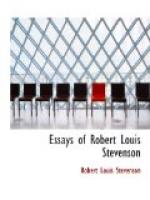[Note 4: The trumpets might sound. “For if the trumpet give an uncertain sound, who shall prepare himself to the battle?” I Cor. XIV, 8.]
[Note 5: The blue-peter might-fly at the truck. The blue-peter is a term used in the British navy and widely elsewhere; it is a blue flag with a white square employed often as a signal for sailing. The word is corrupted from Blue Repeater, a signal flag. Truck is a very small platform at the top of a mast.]
[Note 6: Balaclava. A little port near Sebastopol, in the Crimea. During the Crimean War, on the 25 October 1854, occurred the cavalry charge of some six hundred Englishmen, celebrated by Tennyson’s universally known poem, The Charge of the Light Brigade. It has recently been asserted that the number reported as actually killed in this headlong charge referred to the horses, not to the men.]
[Note 7: Curtius. Referring to the story of the Roman youth, Metius Curtius, who in 362 B.C. leaped into a chasm in the Forum, in order to save his country. The chasm immediately closed over him, and Rome was saved. Although the truth of the story has naturally failed to survive the investigations of historical critics, its moral inspiration has been effective in many historical instances.]
[Note 8: Party for the Derby. Derby Day, which is the occasion of the most famous annual running race for horses in the world, takes place in the south of England during the week preceding Whitsunday. The race was founded by the Earl of Derby in 1780. It is now one of the greatest holidays in England, and the whole city of London turns out for the event. It is a great spectacle to see the crowd going from London and returning. The most faithful description of the event, the crowds, and the interest excited, may be found in George Moore’s novel, Esther Waters (1894).]
[Note 9: The deified Caligula. Caius Caligula was Roman Emperor from 37 to 41 A. D. He was brought up among the soldiers, who gave him the name Caligula, because he wore the soldier’s leather shoe, or half-boot, (Latin caliga). Caligula was deified, but that did not prevent him from becoming a madman, which seems to be the best way to account for his wanton cruelty and extraordinary caprices.]
[Note 10: Baiae was a small town on the Campanian Coast, ten miles from Naples. It was a favorite summer resort of the Roman aristocracy.]
[Note 11: The Praetorian Guard was the body-guard of the Roman emperors. The incident Stevenson speaks of may be found in Tacitus.]




